Promises in JS
See the pyramid shape and all the }) at the end? This is affectionately known as callback hell. The cause of callback hell is when people try to write JavaScript in a way where execution happens visually from top to bottom.
Asynchronous JavaScript uses callbacks, nesting of callbacks results in callback hell. This leads to a code, very hard to read and maintain.
users.get(5, function(err, data){
messges.get(data.userId, function(err, data){
replies.get(data.messageId, function(err, data) {
...
});
});
})
Sync vs Async
In Synchronous programming, the second line of code cannot execute until the previous line has finished its execution. If you are reading a file from database the main thread will be blocked until the file is read, which means no other operation can be done in meantime.
To solve this you have to manage threads manually.
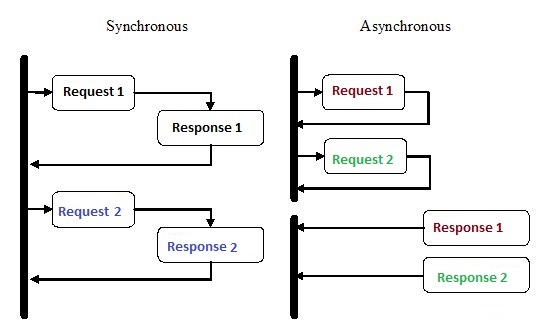
Asynchronous I/O is a form of input/output processing that permits other processing to continue before the transmission has finished.
In Asynchronous programming, a unit of work can run separately from the primary thread. When the work is completed, it notifies the main thread whether the work was completed or failed.
The word ‘Asynchronous’ just means takes some time or happens in the future, not right now.
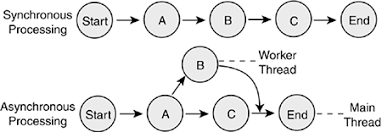
What are callbacks?
A callback function, also known as a higher-order function, is a function that is passed to another function as a parameter.
//Classic example of callback functions in basic JavaScript
var Print = function(eachName, index) {
console.log(index + 1 + ". " + eachName)
}
var friends = ["Mike", "Stacy", "Andy", "Rick"]
friends.forEach(Print) // 1. Mike, 2. Stacy, 3. Andy, 4. Rick
Here we pass a function to
forEachmethod as parameter.
Callbacks are just a convention for using JavaScript functions. Instead of immediately returing a value, a function that uses callbacks takes some time to produce the result. Callbacks are used to achieve single-threaded asynchronous behavior in JavaScript.
In JS, functions are first-class objects. They can be stored in variables, passed as arguments to functions, created within functions, and returned from functions.
When you call a normal function you can use its return value:
function multiplyNums(a, b) {
return a * b
}
var ans = multiplyNums(5, 10)
console.log(ans)
A function that is async and uses callback does not return anything immediately. Instead, you specify the code that should run after the function execution has finished.
downloadPhoto('https://upload.wikimedia.org/wikipedia/en/a/a9/Example.jpg', handlePhoto)
// handlePhoto is passed as callback
function handlePhoto(err, photo) {
if(err)
console.log('Error occured!')
else
console.log('Download finished')
}
In this case, the image may take a very long time to download but our program is not blocked, waiting for the image to be downloaded. When the download finishes the function handlePhoto is called.
Pyramid of Doom
When a programmer accustomed to writing synchronous code, writes asynchronous code in JavaScript, it leads to callback hell.
Nesting of callback is called callback hell.
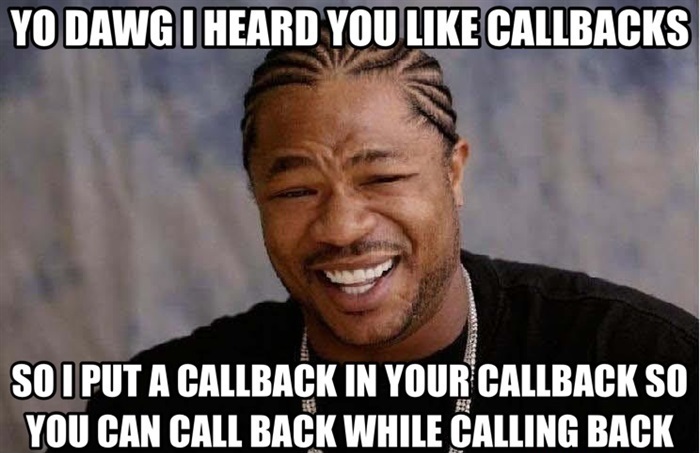
The only way to perform an action when a function finishes is inside a callback. For multiple asynchronous actions that follow one after another we will have code like this:
loadScript('1.js', function(error, script) {
if (error) {
handleError(error);
} else {
// ...
loadScript('2.js', function(error, script) {
if (error) {
handleError(error);
} else {
// ...
loadScript('3.js', function(error, script) {
if (error) {
handleError(error);
} else {
// ...continue after all scripts are loaded (*)
}
});
}
})
}
});
- We load
1.js. - If there is no error, load
2.js. - If there is no error, load
3.js.
As calls become more nested, the code becomes deeper and increasingly more difficult to manage. Soon it spirals out of control.
Promises
A
Promiseis an object representing the eventual completion or failure of an asynchronous operation.
A Promise object represents a value that may not be available but resolved at some time in future. It allows you to write asynchronous code in a more synchronous fashion.
Essentially, a promise is a returned object to which you attach callback, instead of passing callback as a function parameter. The core idea behind promises is that it represents the result of an asynchronous operation.
Promise is in one of three different states.
- Pending - Initial state of promise.
- Resolved - State representing a successful operation.
- Rejected - The state representing failed operation.
Syntax
new Promise( /* executor */ function(resolve, reject) { ... } );
Example:
let promise = new Promise(function(resolve, reject) {
//executor
})
The function passed to Promise constructor is called executor. When a promise is created the executor executes automatically. The resolve and reject functions are called when the promise resolve or reject, respectively.
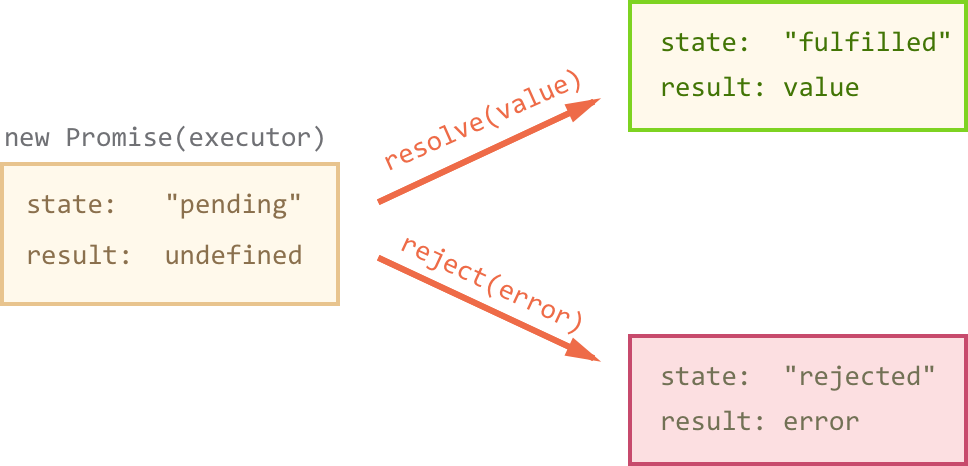
Initially, the promise is in pending state. Executor initiates some async work, once that completes it either calls resolve to resolve the promise or reject if an error occurred.
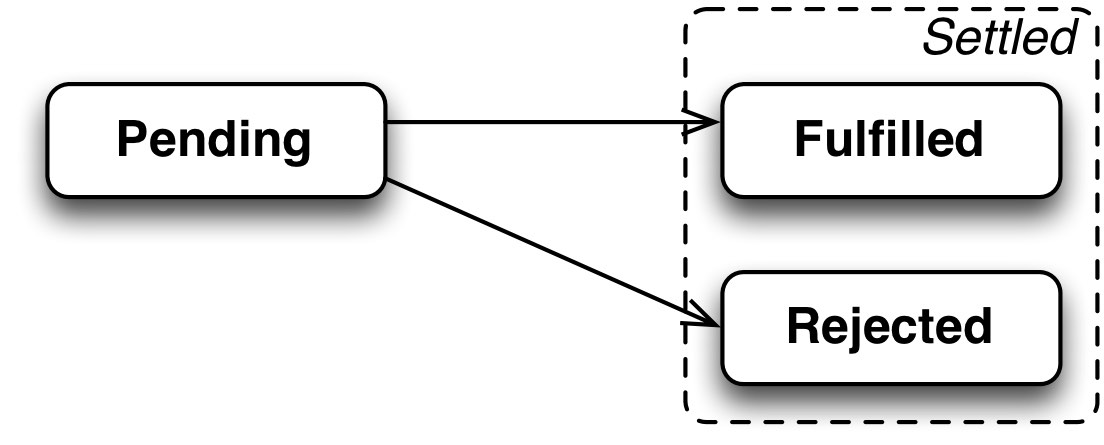
A promise is said to be settled if it is either fulfilled or rejected, but not pending.
Creating a promise
Promise object is created using the new keyword and promise constructor. This constructor takes an ‘executor function’ as an argument. This function should have two parameters, first of these a resolve function. The second, a reject function.
Consumer functions .then and .catch can be registered to receive the result or error. The first argument of then is a function that runs when the promise is resolved and receives the result. The second argument is the function which runs when the promise is rejected and receives the error.
let promise = new Promise((resolve, reject) => {
console.log('Initial')
resolve()
})
promise.then(() => {
console.log("first then")
}, () => {
console.log('Error')
})
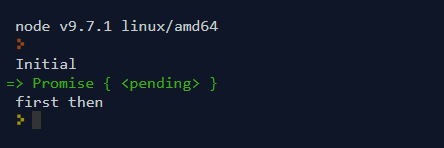
The executor is executed and promise is in pending state. When the promise is resolved the first function of .then is executed.
In case of rejection, the second function will be executed.
For handling errors, we can also use .catch. Which is same as .then(null, errorHandlingFunction).
let promise = new Promise((resolve, reject) => {
console.log('Initial')
reject(new Error('200'))
})
promise.then(() => {
console.log("first then")
}).catch((arg) => {
console.log(`Error: ${arg}`)
})
//Shows 'Initial' then 'Error: 200' as output
Promise Chaining
A common need is to execute two or more asynchronous functions one after the other, where each subsequent operation start when the previous is succeeds. This can be accomplished via promise chaining.
The then() return a new promise, therefore execution is suspended until the promise is resolved. After that, the result of that promise is given to next then().
var f = function() {
return new Promise((resolve, reject) => {
console.log('First')
resolve('200')
})
}
var f1 = function(arg) {
return new Promise((resolve, reject) => {
console.log('Second')
resolve(arg)
})
}
var f2 = function(arg) {
return new Promise((resolve, reject) => {
console.log('Third')
resolve(arg)
})
}
f().then((result) => {
return f1(result)
})
.then((result) => {
return f2(result)
})
.then((result) => {
console.log(result)
})
f1()is called whenf()finishes executionf2()is called whenf1()finishes execution- Order of execution:
f()->f1()->f2()

Promise chaining helps in avoiding ‘callback hell’ or ‘pyramid of doom’.
doAsync1(function () {
doAsync2(function () {
doAsync3(function () {
})
})
)}
We can attach our callbacks to resolved promise, forming a promise chain.
doAsync1.then(function() {
return doAsync2()
})
.then(function() {
return doAsync3()
})
.then(function() {
console.log('Got the final result')
})
.catch(failureCallback);
Promise API
Promise.resolve()
Returns a promise object resolved with given value. The method is used when we already have a value but would like to have it “wrapped” into a promise.
let promise = Promise.resolve(value)
Example:
// Using the static Promise.resolve method
Promise.resolve('Success').then(function(value) {
console.log(value); // "Success"
}, function(value) {
// not called
});
// Resolving an array
var p = Promise.resolve([1,2,3]);
p.then(function(v) {
console.log(v[0]); // 1
});
Further reading: MDN Promise.resolve()
Promise.reject()
The Promise.reject(reason) method returns a Promise object that is rejected with the given reason.
let promise = Promise.reject(error);
Further reading: MDN Promise.reject()
Promise.all()
The Promise.all(iterable) returns a single Promise that resolves when all of the promises in the iterable argument have resolved. It rejects with the reason of the first promise that rejects.
let promise = Promise.all(iterable)
The returned promise resolves when all of the promises are settled and has an array of their results. If any of the passed-in promises reject, Promise.all asynchronously rejects the promise, whether or not the other promises have resolved.
Example:
var promise1 = Promise.resolve(1);
var promise2 = Promise.resolve(2);
var promise3 = new Promise(function(resolve, reject) {
setTimeout(resolve, 100, 'Hello, World!');
});
Promise.all([promise1, promise2, promise3])
.then((result) => {
console.log(result)
})
// Output: Array [1, 2, "Hello, World!"]
- If an empty iterable is passed, then this method returns (synchronously) an already resolved promise.
- If all of the passed-in promises fulfill or are not promises, the promise returned by
Promise.allis fulfilled asynchronously.
A common trick is to map an array of jobs into an array of promises, and then wrap that into Promise.all().
For example, we can fetch an array of URLs in the following way:
const fetch = require('node-fetch')
let UserNames = ['rishabhc32', 'mittalprince', 'geekychaser']
let req = UserNames.map(name => fetch(`https://api.github.com/users/${name}`))
// 'fetch' returns a 'Promise<response>' for URL passed in argument
console.log(req)
Promise.all(req)
.then((result) => {
result.forEach( (element) => {
console.log(`${element.url}: ${element.status}`)
})
})
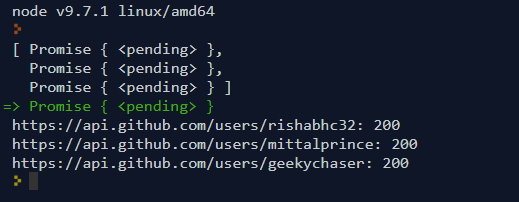
Fail-safe Promise.all()
Promise.all is rejected if any of the elements are rejected. For example, if you pass in three promises and one promise rejects immediately, then Promise.all will reject immediately.
It is possible to change this behavior by handling possible rejections:
var url = 'https://github.com/rishabhc32'
Promise.all([
fetch(url),
fetch('malformed-url').catch(error => {return error})
])
.then(response => {
console.log(`${url}: ${response[0].status}`)
console.log(`Error: ${response[1].message}`)
})
Output:
> https://github.com/rishabhc32: 200
> Error: Only absolute URLs are supportedThis will wait until all promises are settled.
Promise.race()
The Promise.race(iterable) method returns a promise that resolves or rejects as soon as one of the promises in the iterable resolves or rejects.
let promise = Promise.race(iterable);
The first result/error becomes the result of the whole Promise.race. All further results from resolved promises are ignored.
Example:
var promise1 = new Promise((resolve, reject) => {
setTimeout(resolve, 500, 'First');
})
var promise2 = new Promise((resolve, reject) => {
setTimeout(resolve, 100, 'Second');
})
Promise.race([promise1, promise2]).then(function(value) {
console.log(value);
// Both resolve, but promise2 is faster
})
// Output: "Second"
Further reading: MDN Promise.race()
Promise.finally()
The Promise.finally() return a Promise when the promise is settled, regardless of its outcome.
let p = new Promise( ... )
p.finally(function() {
// settled (fulfilled or rejected)
})
The callback specified in Promise.finally is always executed when the promise is settled(resolved or rejected). The finally() method can be useful if you want to do some processing or cleanup once the promise is settled.
Example:
let p = Promise.reject('hello')
p.then(() => {
console.log('Resolved')
})
p.catch(() => {
console.log('Error')
})
p.finally(() => {
console.log(`Finally`)
})
Output:
> "Error"
> "Finally"
Promise.finally()is part of ECMAScript specification but not yet included in NodeJS. It is only a matter of time before it lands in Node.js.Further reading:
Next up
Update – 9 July
Async/await in JavaScript is up.